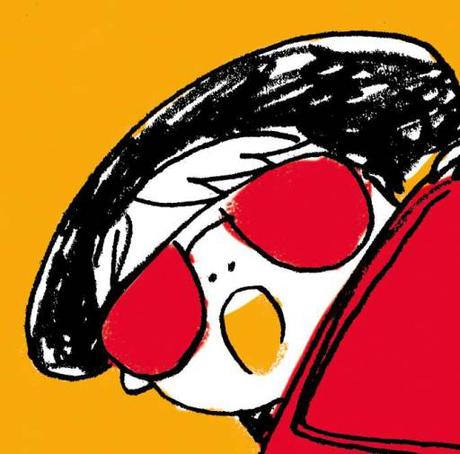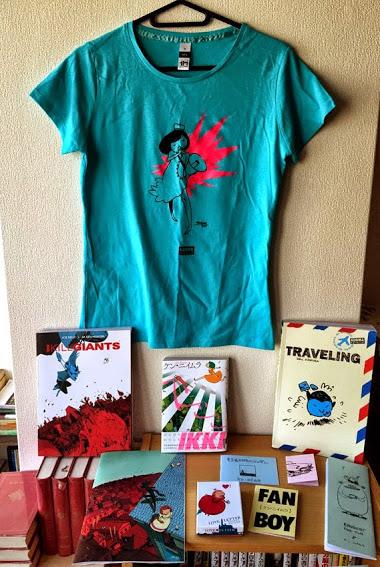 The first thing that will strike you about speaking to the creator of Henshin and Eisner nominated artist of I KILL GIANTS is his English is solid, considering he grew up in Spain and now lives in Tokyo working on manga for a manga publisher.
The first thing that will strike you about speaking to the creator of Henshin and Eisner nominated artist of I KILL GIANTS is his English is solid, considering he grew up in Spain and now lives in Tokyo working on manga for a manga publisher.
The second thing that will strike you is him expressing surprise when learning that Kengo Hanazawa’s I Am a Hero, which Jason Thompson said in his House of Manga column, “is probably the greatest zombie manga ever,” was not licensed in the US. “It’s like Walking Dead set in Japan. It’s really great!” He believes it’ll come over sometime soon.
The third thing that will strike you is him talking about a trip to a bar called Cabbages that are run by two twins in their 70’s. “They used to be singers,” he said, ” They made their debut, then they quit, they started this bar, and they sing for you.”
This is apparently the start of the “unique” life in Japan, and how it ultimately ties into the creation of Henshin.
Ken Niimura’s path to becoming a comic artist, before even thinking about becoming a mangaka, started not in Japan, but in the capital of Spain, Madrid. As the son of a consultant for Japanese firms and housewife who can speak 6 different languages, Niimura grew up learning a lot of things, a lot of cultures, and a lot of languages. He soon enough learned about comics, and eventually discovered that was the road he wanted to travel. “I seriously started drawing when I was 15,” he mentioned as we conversed on how he broke into the comic scene. “So from then on I thought about how to make a living, but I would like to make comics.”
From being inspired by a wide range of them — Doraemon, Dragonball, Saint Seiya in Japan, Asterix, Tintin in France, Super Lopez in Spain — and Hayao Miyazaki’s Laputa and Nausicaa (“me and my sister watched those over and over and over,” he emphasized), Niimura contributed his drawings to a number of different magazines, did illustrative work, and did what he could to get on the radar of publishers and editors. That lead to him being able to work with Joe Kelly on I KILL GIANTS, which tells the story of a girl that’s struggling socially escaping into a fantasy life where giants and pixies exist. It was nominated for an Eisner in 2010, and won the Gold award in the 5th International Manga Award competition in 2012.
So, with that experience and looking at what he wanted to do after working on I KILL GIANTS, he decided to plan to work on manga in Japan. After spending a few years speaking with editors and artists — along the way he talked to Takeshi Obata, Takehiko Inoue, Katsuhiro Otomo, and Taiyo Matsumoto — he made the move to Tokyo, and that’s where he resides right now.
It’s been his time there that ultimately jumps toward how Henshin got started.

Organization ASG: So how did Henshin get started? Was it an idea you had in mind after some sort of event, editor suggestion, etc?
Ken Niimura: After doing I KILL GIANTS and collaborating with other people, I felt like working on my own stories. Looking at all the possibilities I had around, Japan was probably the place where I could work on my own stories, having the help of a publisher. So after 2 or 3 years of visiting Japan and getting to know editors and authors, I got the chance to talk to the editors of IKKI, which is a magazine I have admired for a really long time.
Japan is a very analogical country, so when it comes to doing comics, the usual thing is to be in Tokyo and have meetings with an editor face to face. I moved to Japan, because I was aware I wouldn’t have any chance of doing this from abroad. I worked with an editor for a year on a project that ultimately didn’t get done for a variety of reasons, and then they told me that they were preparing a series of web comics and one of them would be mine. In Japan, it’s usual that an editor will have you work on short stories, to help the author hone their craft and as a means for an editor to get to know the author.
What’s great about IKKI is that it’s a magazine where the authors have the freedom to do whatever they want. They told me I could do a science fiction, a romance, a story on pirates, just do whatever I wanted to. And for a while, I was paralyzed by such freedom and I had no idea what to do. Too much freedom? Yeah, I realized that you need to start a project with a set of rules for yourself, like “I’m going to work on this environment,” or “I’m going to talk about this subject”.
To me, doing comics is in a way similar to running a restaurant. You go to the market, you choose all the best ingredients that you have available depending on the season and where you live, and you cook and serve it to your customers, hoping that they will enjoy them. So the basic principle for Henshin is doing the same for comics: I take stuff I’ve seen in my daily life in Tokyo, and I process or modify it in a way that allows me to tell what I want to say. And both creating stories and cooking, you need to modify something, or to transform it – that’s why I chose the title Henshin.
OASG: So you didn’t name it Henshin simply because you’re a big Super Sentai fan right?
Ken: *laughs* I’m really not that much of a sentai fan, although I enjoy watching some sometimes. I chose henshin because it has quite a wide meaning in Japanese and because it’s a word that’s familiar to many people abroad too. I think it works and is a really honest and simple way to define the whole project!
OASG: The theme of Henshin, as you’ve mentioned, involves “change”, where certain events ultimately change people, for better or worse. As I was reading it, I felt like for most of the stories the theme was more like “people are not who they seem.” Is this a fair interpretation?
Ken: I think especially for short stories, that’s quite like it. Because you have a very limited space, you make a whole plan to take the readers from where they think the first idea is to where you would like them to go. Many of the stories begin with something that looks like one thing but it’s actually very different, and that’s something that I personally like when I read short stories – that you can read them several times and discover new things here and there.
OASG: Like for the very first story, how was I supposed to tell Nat-chan’s uncle had a different side to him until she ended up finding the gun?
Ken: *laughs* Well once you know it, you can go back and see the way he behaved, stuff like that.
OASG: There are stories that involve you with a cat. A) Do you finally own a cat? Please tell me you do *laughs*
Ken: *laughs* I don’t! You see, you have this thing in Japan where certain apartments don’t allow you to have pets and on the other hand I don’t have the means to take care of a cat… That’s why I thought, if I can’t have a real cat, then why not use a comic to give myself a fictional one.
There are two stories — the kitty and me and cat on guard — that are more or less inspired by real facts, there are actually cats that come around my home and are playing and I hear and see them.
OASG: B) Is there anything about those stories involving you that you wish you could’ve added?
Ken: For this one book, I think those 4 biographical stories work together very well, but while working on them I had tons of other ideas, stories that took different directions, but just didn’t fit in the atmosphere of the book. There’s certainly stuff that I would love to tell, had this been a different book.

OASG: I liked a lot of the stories in the book, but there were a few I particularly loved. One happened to involve what I interpreted as a suicide group. They were having a picnic and eventually they’re gonna try and kill themselves. What was the thought process behind creating that story?
Ken: Every summer I go with friends to a small village and we have BBQs, swim in the river, and go to the summer festival. It’s like 2 or 3 days of peaceful life in the countryside and something that I always look forward to.
I thought that I would really like to use that positive feeling as the beginning of the story, but adding something to it that is the total opposite. And then I remembered those stories about people in Japan that go and commit suicide in groups, and thought it would be fun to switch the atmosphere from something very, very bright to something really, really dark and work with that tension.
OASG: What would you say challenged you the most about on working on all these short stories?
Ken: The most difficult part was finding something that works in a very limited amount of pages, and that’s fun and direct but at the same time has an extra layer to make the stories more interesting. I certainly spent more time writing than drawing. Writing a particular story would take two weeks or so, while the actual drawing would be done in no more than one week.
OASG: How was working on Henshin like compared to working on I KILL GIANTS?
Ken: Well besides the fact that I had a script for I KILL GIANTS and I didn’t have it here, when it comes to the way you tell a story or how you write them, the basic difference here is I KILL GIANTS was done in English and set in the U.S, and made with an American audience in mind; in the case of Henshin, it was made for a Japanese audience, in a Japanese setting, in the Japanese market, using Japanese as a language.
I find it sometimes difficult to tell what’s the difference between a US comic, a European comic, or manga. I can tell there are differences, and they feel different when I read them.
Thanks to the experience of working on I KILL GIANTS in English and Henshin in Japanese, I do know that some of these differences exist because of the language. To me, English is a language that’s more direct than Japanese – more accurate, more direct, more dynamic; in Japanese there’s more ellipsis, sometimes you don’t exactly know who the subject is or certain things are understood by the context, which is something that rarely happens in English.
I think something similar might happen in the way stories are told in comics: the Japanese way has more ellipsis and the pacing feels different due to the language and the connections they make. Working on I KILL GIANTS and Henshin was for me in a way a switching between languages: you have to adjust certain things depending on the reader.
OASG: What do you hope people who read Henshin ultimately take away from it?
Ken: I hope they can find a specific moment or story or scene where they think of, “Oh I’ve thought or felt something similar,” or “I’ve been through that”. Being able to connect with a reader from a different country and culture and know that we have something, even if very small, in common would mean a lot to me.

